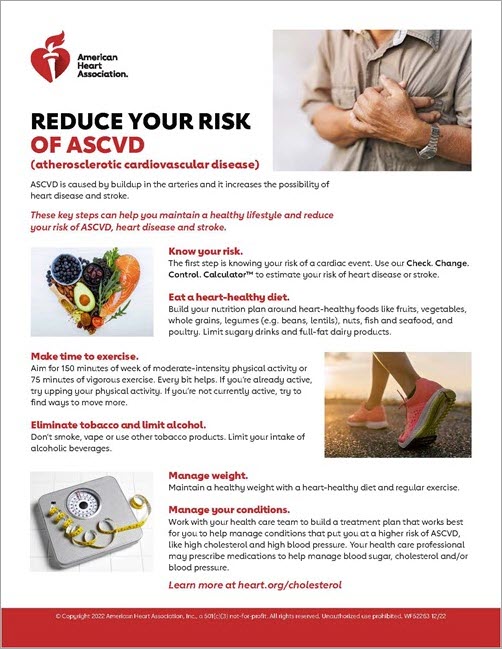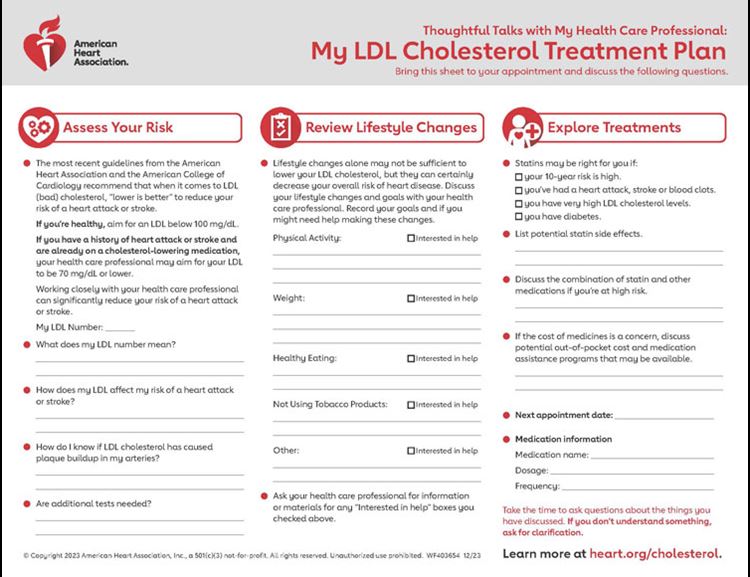Prevention and Treatment of High Cholesterol (Hyperlipidemia)
Know your numbers – and what to do about them.
When it comes to cholesterol, it's important to know your numbers. Hyperlipidemia means your blood has too many lipids, or fats, such as cholesterol and triglycerides. One type of hyperlipidemia is hypercholesterolemia, which means you have too much non-HDL cholesterol and LDL (bad) cholesterol in your blood. This condition increases fatty deposits in arteries and the risk of blockages.
Another way your cholesterol numbers can be out of balance is when your HDL (good) cholesterol level is too low. With less HDL to remove cholesterol from your arteries, your risk of plaque and blockages increases. Atherosclerotic cardiovascular disease, or ASCVD, involves plaque buildup in artery walls which includes conditions such as acute coronary syndrome and peripheral artery disease, and can cause a heart attack, stable or unstable angina, stroke, transient ischemic attack or aortic aneurysm.
View Reduce Your Risk of ASCVD (PDF) | Spanish (PDF)
If you’re diagnosed with high cholesterol, your overall health and other risks such as smoking or high blood pressure will help guide treatment. These factors can combine with high LDL cholesterol or low HDL cholesterol levels to affect your cardiovascular health. Your health care professional may use the ASCVD Risk Calculator to assess your risk of a coronary event in the next 10 years.
The good news is that high cholesterol can be lowered, reducing the risk of heart disease and stroke. If you’re 20 years or older, have your cholesterol tested and work with your health care professional to adjust your cholesterol levels as needed.
Often, changing behaviors can help bring your numbers into line. If lifestyle changes alone don’t improve your cholesterol levels, medication may be prescribed. Lifestyle changes include:
Eating a heart-healthy diet
From a dietary standpoint, the best way to lower your cholesterol is to reduce your intake of saturated fat and trans fat. The American Heart Association recommends limiting saturated fat to less than 6% of daily calories and avoiding trans fats.
Reducing these fats means limiting your intake of red meat and dairy products made with whole milk. Choose skim milk, low-fat or fat-free dairy products instead. It also means limiting fried food and cooking with healthy oils, such as vegetable oil.
A heart-healthy diet emphasizes fruits, vegetables, whole grains, poultry, fish, nuts and nontropical vegetable oils, while limiting red and processed meats, sodium and sugar-sweetened foods and beverages.
Many diets fit this general description. For example, the DASH (Dietary Approaches to Stop Hypertension) eating plan promoted by the National Heart, Lung, and Blood Institute as well as diets suggested by the U.S. Department of Agriculture and the AHA are heart-healthy approaches. Such diets can be adapted based on your cultural and food preferences.
To be smarter about what you eat, pay more attention to food labels. As a starting point:
- Know your fats. Knowing which fats raise LDL cholesterol (saturated and trans fats) and which ones don’t (unsaturated fats) is key to lowering your risk of heart disease.
- Cook for lower cholesterol. A heart-healthy eating plan can help you manage your blood cholesterol level.
Being more physically active
A sedentary lifestyle lowers HDL (good) cholesterol. Less HDL means there’s less good cholesterol to remove bad cholesterol from your arteries.
Physical activity is important. At least 150 minutes of moderate-intensity aerobic exercise a week is enough to lower both cholesterol and high blood pressure. And you have lots of options: brisk walking, swimming, bicycling or even vigorous yard work can fit the bill.
Learn more about getting active.
Quitting smoking
Smoking and vaping lowers HDL cholesterol.
Worse still, when a person with unhealthy cholesterol levels also smokes, the risk of coronary heart disease increases more than it otherwise would. Smoking also compounds the risk from other risk factors for heart disease, such as high blood pressure and diabetes.
By quitting, smokers can lower their triglycerides and increase their HDL cholesterol levels. It can also help reduce damage and improve how their arteries function. Nonsmokers should avoid exposure to secondhand smoke.
Learn more about quitting smoking.
Losing weight
Being overweight or obese tends to raise the chances of increasing bad cholesterol and lowering good cholesterol. But a weight loss of as little as 5% to 10% may help improve some cholesterol numbers and other heart disease risk factors.
Learn more about losing weight.
Thoughtful Talks With My Health Care Professional: My Cholesterol Treatment Plan
Your health care professional can help you reach your health goals, including keeping your cholesterol at healthy levels.
Making decisions with your health care team is the best way to create a treatment plan you’ll be more likely to stick to. If you don’t understand something, ask for further clarification.
Here’s a helpful checklist (PDF) that you and your health care professional can go through to determine your risk and the best treatment options for you.

